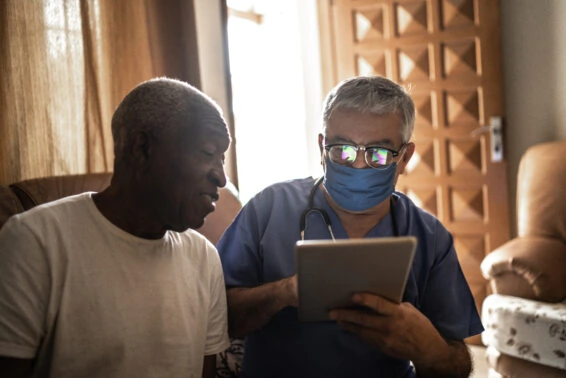Your Genesys Blog Subscription has been confirmed!
Please add genesys@email.genesys.com to your safe sender list to ensure you receive the weekly blog notifications.
Subscribe to our free newsletter and get blog updates in your inbox
Don't Show This Again.

If you work in healthcare, you might have reminisced about going back to pre-pandemic work pressures and concerns. Most organisations are now consistently speaking out about their “new normal,” and how they’re addressing outcomes associated with improving patient care and safety, increased staffing shortages, retention concerns, stifled earnings growth, and ongoing operational uncertainty of the COVID-19 pandemic’s long-term effects. For many healthcare providers, 2021 was optimistically going to be the year of the return to normalcy after an overwhelming 2020. But, as we enter 2022, a majority have come to realise healthcare is entering a new chapter that will permanently replace our perspectives of the past.
New care models, technologies and patient demands present themselves at an increasingly staggering rate. These shifts affect how healthcare administrators and caregivers think about the ways they deliver care to patients. As we navigate the evolution to a new normal, here are five lessons healthcare professionals learned from 2021 that will help them succeed in 2022.
1. We need to intentionally find ways to show true empathy for our caregivers. Overwhelming exhaustion of COVID-19 volumes of care, excessive paperwork, electronic health records (EHR) disfunction, dynamic regulations and reimbursement constraints have found ways to diminish energy and passion of those who have taken on the commitment to care for others. We also must understand that staffing shortages will be a long-term problem, so empowering the people we have today becomes more important.
2. We need to address the fact that patients have lost trust in the care they receive. Uncertainty and frustrations about diagnoses, treatments, vaccinations, and political views have created a barrier between the patient and the caregiver. It’s important to find new ways to create opportunities for interactions that can rebuild the trust and connection here to ensure we don’t deviate from our organisational quality of care objectives.
3. Patients should be seen equally as consumers. The pandemic has caused US health systems to experience billions of dollars in loss through decreased services and a lag in more profitable elective procedures. Non-traditional health organisations have taken advantage of this opportunity, further disrupting what’s considered as care and how it can look. Tracking and understanding the expectations of the new healthcare consumer will be critical to long-term retention and satisfaction.
4. Patients expect to be treated for more than a traditional medical condition. We must find ways to turn business visions of health equity, social determinants of health and patient-centred care into active operational practices we can track and improve.
5. People want care anytime — anywhere. Telehealth is identified as a top strategic priority for healthcare leaders in 2022. The use of telehealth technology through the start of the pandemic in 2020 met a basic need for care access and continuation. But, more importantly, it showed patients that care can be done differently. To meet this demand, organisations must quickly shift to a more technology-driven, patient-centric approach. As remote patient monitoring and telehealth 2.0 further emerge in 2022, we need to determine how best to orchestrate these new expectations.
Our lessons learned from 2021 have one common theme: People-centric experiences matter. Healthcare will be just as complex in 2022 as it has been prior, but now there’s an opportunity to capitalise on the shift toward an experience-driven economy.
The levers of unsustainable rising medical costs, patient generational shifts, health consumerism and modernisation of care delivery will continue to drive the need to focus on the patient experience. We must listen, understand, act and learn for every interaction that occurs with employees, consumers and associated partners to drive exceptional end-to-end experiences.
Based on our lessons from 2021, healthcare providers need to take focus on five key experience journeys. Those experience journeys include addressing patient activation, patient access, care planning, treatment and discharge, and ongoing health monitoring. For each experience journey, organisations should assemble a team of experience advocates who understand stakeholders as well as associated business-related KPIs. These advocates must also know when and how interactions should occur — and what additional orchestration signals affect those interactions. At Genesys, we’re partnering with our healthcare provider, payor and life sciences clients to help address these needs and deliver experiences for better outcomes.